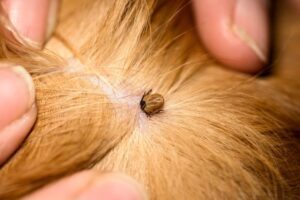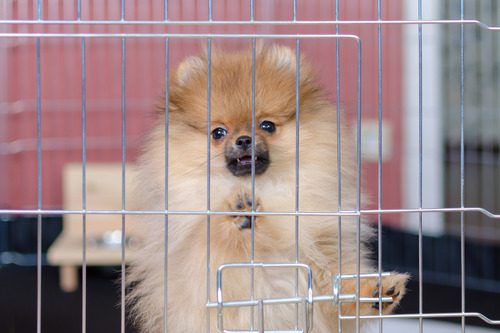How to Keep Your Dog Tick Free – And What to Do if They Get One
Dogs love to play outside, and we love to see them happy. With warmer temperatures and summertime comes an increase in ticks that like to make a home in our pup’s skin and fur.
Ticks can carry a multitude of diseases, most notably Lyme disease. If left untreated, these diseases can cause organ failure and even death. With that being said, we want to protect our pups from getting ticks In the event that they do get a tick, we want to know exactly what to do.
So how do you keep your dog tick free, and what do you do if your dog gets a tick?
Chewables, topical protection, and grooming can help prevent ticks on dogs. If your pup does get a tick, you need to find the tick, carefully remove it and store it, wash the area, and keep an eye on it and your pup in the following days and weeks.

How To Keep Your Dog Tick-Free
The best way to avoid your pup getting a tick is to follow these procedures:
1. Chewables
There are tons of great chewable options for your dog’s tick prevention. These oral options seem like the easiest method of protection for busy pups and pup parents on the go.
Depending on the brand and type, a single chewable may last anywhere from a few days to up to a month. Just make sure you are setting reminders to give your pup their chewable so they don’t have a lapse in protection!
2. Topical Protection
Traditionally, topical protection has been the mainstay for tick prevention. Topical prevention comes in the form of both collars and ointments.
Collars are worn around your pup’s neck, just like a traditional collar, and they release a tick-protecting drug that gets soaked into your dog’s skin glands and hair follicles.
Ointments are manually administered on to your pup’s body from the neck area. From the neck area, the oils in the ointment will spread to protect the entire body, similar to how the collars work.
Most topical protections last around 30 days, but some, like SORESTO, can last upwards of 8 months!
3. Grooming
Other than the standard health and wellness benefits of grooming, most groomers do offer a flea and tick shampoo as an add-on to traditional grooming services. However, similar to other methods, this shampoo’s protection often lasts a month or so, so subsequent visits may be needed to ensure your pup is protected.
4. Monitor Your Pup’s Skin after Playing Outside
After playing outside, be sure to give your pup a quick lookover to make sure a tick didn’t find their way on to your pup! Tick combs are a great tool that allow you to quickly comb over your pup’s fur.
In the event that you do find a tick, remain calm and read on!
What to Do if Your Dog Has A Tick
If you do find a tick on your beloved pup, follow the steps below:
1. Find The Tick
This one may seem like a no-brainer, but if you suspect your dog has gotten a tick, you must first need to find the tick.
Ticks love hiding in dark, moist places so be sure to thoroughly check under your pup’s collar, in their armpits, in between their toes on their paw, and in their groan area. If your pup is excessively licking or scratching a certain area of their skin, that may be a sign of a tick as well.
Ticks are small, dark-colored insects, so they may be very hard to see, especially when surrounded by fur. Be sure to keep that in mind when scanning your pup for ticks.
2. Remove The Tick
When you first locate the tick, your immediate reaction will likely be to pull it out with your fingers.
Instead of pulling the tick out with fingers, take a pair of tweezers, spread the fur, and pull in a steady motion close to where the tick’s head is. Pull the entire tick away from the skin, and do not crush the tick, twist the tick, or pull too fast.
Remember to pull all of the tick away. Failure to pull all of the tick, crushing or twisting the tick, or pulling too fast can cause infection due to leaving a part of the tick behind.
Ticks borough their head into the skin, so it can be tricky to pull the insect out without tearing it or leaving its head stuck in your pup’s skin. Just be sure to position your tweezers as close to the tick’s head as possible and pull in a smooth and steady motion.
3. Wash The Area
After removing all of the tick, wash the dog’s skin with warm and soapy water. Then, dry the area thoroughly, and put a dab of dog-friendly ointment, such as hydrocortisone cream, on the area.
You can also put three percent hydrogen peroxide on a tick bite to destroy the bacteria that causes Lyme disease. However, as this contains bleach, it should only be poured onto light-haired dogs since it could bleach your pup’s hair. To avoid this, use an eye dropper to carefully administer hydrogen peroxide on dark-haired dogs.
4. Store The Tick
Finally, store the tick by putting it in a jar or sandwich bag and label it with the date and where you found it on your dog. We want to store the tick for at least two weeks, just in case your pup develops symptoms from the bite.
If your dog does develop symptoms, see a veterinarian immediately. The vet may need the tick and the information from the tick bite (date, location of bite, etc.) to determine the next steps to take.
5. Check Up on Your Pup
Be sure to check the area for a couple of days to ensure it doesn’t get red or infected. If it does, and the dog becomes lethargic or shows other signs of sickness, see your veterinarian immediately.
An infected bite may show in a couple of days, but symptoms of tick-borne diseases may take 7 to 21 days to show up in your pup.
Conclusion
Preventing ticks on your pup is always easier than treating ticks! There are tons of simple methods on the market that aid with tick prevention on dogs.
If you have any questions about tick prevention, or if you are worried about your pup being bitten by a tick, reach out to Brown Veterinary Hospital. Our Terre Haute, IN team of veterinarians and staff is here to help you with any questions or concerns!
Recent Posts
About Brown Veterinary Hospital
We are here to serve as your partner in keeping your four-legged family member healthy, ensuring you have all the tools you need to provide them with a lifetime of outstanding care. Our animal hospital in Terre Haute offers a full range of services to nurture and extend your pet’s life, from wellness and preventative care to critical care, exotic pet care, and dermatology.





